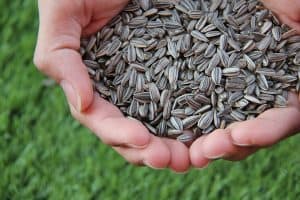Omega-6 fatty acids (often called just omega-6 fats) are a group of polyunsaturated fatty acids (PUFAs) that are important for a number of functions in the body. They are a type of essential fatty acid so-called because they are required by the body, but cannot be manufactured or synthesized by the body. Therefore, your diet is an important source of these fats. Omega-6 fats are essential for proper development and functioning of the brain and nervous system. They also stimulate skin and hair growth, provide and maintain good bone health, help regulate the metabolism, and help keep the reproductive system healthy.
There are several omega-6 fats, including: linoleic acid (one of several), eicosadienoic acid, gamma-linolenic acid (GLA), and arachidonic acid (AA or ARA).
Where are these omega-6 fats found? In lots of food items, such as: vegetable oils, seeds, nuts, and even in eggs and poultry. Further, the vegetable oils that are very high sources of omega-6 fats are abundant in our modern diet – corn oil, sunflower oil, safflower oil, soybean oil, and more. If you look at the ingredient list of many processed foods, you’ll find one or more of these oils as an ingredient often.
Benefits of Omega-6 Fats
The other type of essential fatty acid that your body cannot produce, but required for proper function, are the omega-3 fatty acids. Unlike the omega-6s, these are much more rare in the modern American diet – they are found in cold-water, fatty fish such as salmon and sardines, other types of seafood, and in some plant based foods – such as walnuts. The omega-3 fats seem to confer significant health benefits. But, some research indicates that having too much omega-6 fat in your diet can interfere with the proper utilization of omega-3 fats – and that’s why you’ll often hear about omega-6 to omega-3 ratios. Continue reading this article for further information on that topic.
We’ve already established they are essential fats and help keep several key body functions working properly – that’s obviously important. But there are other benefits we can examine. Omega-6 fat helps lessen the risks of diabetic neuropathy, rheumatoid arthritis and even allergies. They have also shown some benefits for those suffering from ADHD. And lastly, these polyunsaturated fats are often used to help lower the risk of heart disease by decreasing LDL cholesterol (the “bad” cholesterol), and increasing HDL cholesterol (the “good” cholesterol.)
In the body linoleic acid can be converted to something called gamma-linolenic acid (GLA), and GLA is also found in some of the plant-based oils (such as primrose or borage oil). GLA seems to have an anti-inflammatory effect on the body. Similarly, GLA seems to have positive impacts for those suffering allergies and rheumatoid arthritis.
While GLA seems to have anti-inflammatory effects, most of the other omega-6 fats have a pro-inflammatory impact.
Omega-6 to Omega-3 Fat Ratio or Balance
Western diets tend to be very high in Omega-6 fats, especially in comparison to Omega-3 fats. While some Omega-6 fats (such as GLA) seem to lower inflammation, too much of the linoleic acid variety found in vegetable oils promotes inflammation. And in case you haven’t checked the ingredient list on your processed foods lately – you might be surprised – there’s a lot of vegetable oil in most of them.

If you’ve read our article on Omega-3 fats, you know intake of these is associated with significant health benefits. But, excess omega-6 fatty acids from vegetable oils seem to interfere with the health benefits of omega-3 fats – possibly because they compete for the same enzymes within the body. A high proportion of omega-6 to omega-3 fat in the diet shifts the physiological state in the tissues toward the pathogenesis of many diseases: prothrombotic (clotting), proinflammatory (inflammation) and proconstrictive (restricted blood flow). And this is not just theory – studies have shown that too much Omega-6 in relation to Omega-3 is associated with increased risk of several chronic inflammatory diseases such as nonalcoholic fatty liver disease (NAFLD), cardiovascular disease (CVD), obesity, inflammatory bowel disease, rheumatoid arthritis, and Alzheimer’s disease.
Studies suggest there may be an ideal ratio of Omega-6 : Omega-3, that is far less than what is achieved with the typical American diet. Some researchers have recommended anywhere from a 4:1 to 1:1 ratio. That’s far different from the 10:1 or even 20:1 ratio that the average industrialized diet currently provides.
The Mediterranean diet is an example of a diet that provides for a more favorable Omega-6:Omega-3 ratio. It is believed this may be the reason that this diet is associated with a lower risk of heart disease – but that hasn’t been proven conclusively.
You can cut down on omega-6 levels by reducing consumption of processed and fast foods and polyunsaturated vegetable oils (corn, sunflower, safflower, soy, and cottonseed, for example). At home, use extra virgin olive oil for cooking and in salad dressings. Eat more oily fish or take fish oil supplements, walnuts, flax seeds, and omega-3 fortified eggs. In particular try to minimize or eliminate the seed and vegetable based oils – and the foods that contain them.

Sources of Omega-6 Fats
Omega-6 fats are present in a lot of our food items – and that’s good, because they are essential. But certain foods have a major abundance. Again, those vegetable oils that are all too common in our modern industrialized diet are major sources of Omega-6 fats. Here’s some foods that contain Omega-6 fats:
- poultry
- eggs
- nuts
- hulled sesame seeds
- cereals
- durum wheat
- whole-grain breads
- most vegetable oils
- grape seed oil
- evening primrose oil
- borage oil
- blackcurrant seed oil
- flax/linseed oil
- rapeseed or canola oil
- hemp oil
- soybean oil
- cottonseed oil
- sunflower seed oil
- corn oil
- safflower oil
- pumpkin seeds

In Summary
We know that Omega-6 fats are essential to life and health – but they are also highly abundant in our modern diet. Because they can impact the proper utilization of omega-3 fats, which have significant health benefits, it seems that we should try to lessen our intake of omega-6 fats and increase our intake of omega-3 fats.
References

Tim is the founder of FitAtMidlife.com – an avid gym rat for 30+ years, he’s a reviewer of many, many shoes – and founder of the Speed Bag Gathering – the world’s only gathering of speed bag punching enthusiasts. See more gym reviews at Tim’s YouTube channel.


I really enjoyed this article. I think the take-home point is that you have to look at the balance of polyunsaturated fats in your meal. As your article suggests, we want the overall ratio of O3:O6 to be about 1:2. Moreover, since many foods we at contain corn (which all Omega 6), making a choice to choose oils that Omega 3 dominate (e.g. walnut oil over safflower seed oil) helps us keep inflammation to a minimum. Thanks for posting!